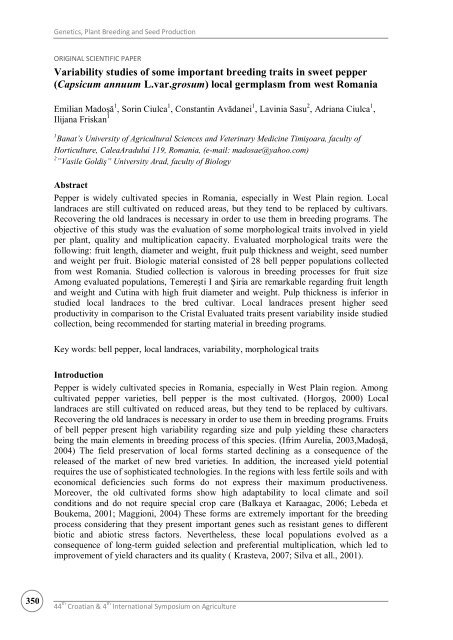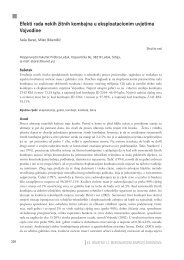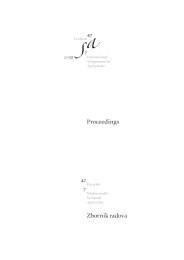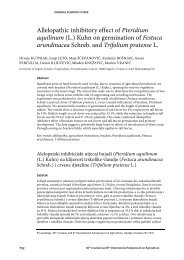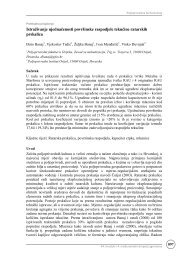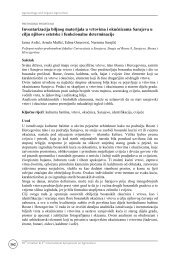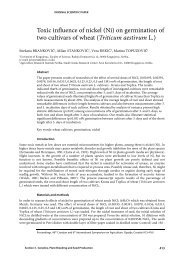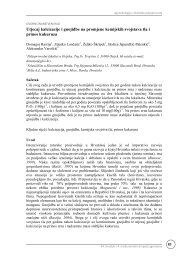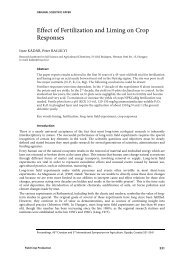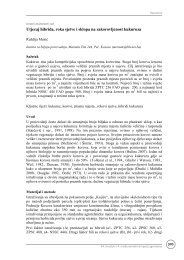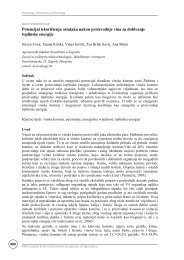Variability studies of some important breeding traits in sweet ... - hr
Variability studies of some important breeding traits in sweet ... - hr
Variability studies of some important breeding traits in sweet ... - hr
Create successful ePaper yourself
Turn your PDF publications into a flip-book with our unique Google optimized e-Paper software.
350<br />
Genetics, Plant Breed<strong>in</strong>g and Seed Production<br />
ORIGINAL SCIENTIFIC PAPER<br />
<strong>Variability</strong> <strong>studies</strong> <strong>of</strong> <strong>some</strong> <strong>important</strong> <strong>breed<strong>in</strong>g</strong> <strong>traits</strong> <strong>in</strong> <strong>sweet</strong> pepper<br />
(Capsicum annuum L.var.grosum) local germplasm from west Romania<br />
Emilian Madoşă 1 , Sor<strong>in</strong> Ciulca 1 , Constant<strong>in</strong> Avădanei 1 , Lav<strong>in</strong>ia Sasu 2 , Adriana Ciulca 1 ,<br />
Ilijana Friskan 1<br />
1 Banat‟s University <strong>of</strong> Agricultural Sciences and Veter<strong>in</strong>ary Medic<strong>in</strong>e Timişoara, faculty <strong>of</strong><br />
Horticulture, CaleaAradului 119, Romania, (e-mail: madosae@yahoo.com)<br />
2 ”Vasile Goldiş” University Arad, faculty <strong>of</strong> Biology<br />
Abstract<br />
Pepper is widely cultivated species <strong>in</strong> Romania, especially <strong>in</strong> West Pla<strong>in</strong> region. Local<br />
landraces are still cultivated on reduced areas, but they tend to be replaced by cultivars.<br />
Recover<strong>in</strong>g the old landraces is necessary <strong>in</strong> order to use them <strong>in</strong> <strong>breed<strong>in</strong>g</strong> programs. The<br />
objective <strong>of</strong> this study was the evaluation <strong>of</strong> <strong>some</strong> morphological <strong>traits</strong> <strong>in</strong>volved <strong>in</strong> yield<br />
per plant, quality and multiplication capacity. Evaluated morphological <strong>traits</strong> were the<br />
follow<strong>in</strong>g: fruit length, diameter and weight, fruit pulp thickness and weight, seed number<br />
and weight per fruit. Biologic material consisted <strong>of</strong> 28 bell pepper populations collected<br />
from west Romania. Studied collection is valorous <strong>in</strong> <strong>breed<strong>in</strong>g</strong> processes for fruit size<br />
Among evaluated populations, Temereşti I and Şiria are remarkable regard<strong>in</strong>g fruit length<br />
and weight and Cut<strong>in</strong>a with high fruit diameter and weight. Pulp thickness is <strong>in</strong>ferior <strong>in</strong><br />
studied local landraces to the bred cultivar. Local landraces present higher seed<br />
productivity <strong>in</strong> comparison to the Cristal Evaluated <strong>traits</strong> present variability <strong>in</strong>side studied<br />
collection, be<strong>in</strong>g recommended for start<strong>in</strong>g material <strong>in</strong> <strong>breed<strong>in</strong>g</strong> programs.<br />
Key words: bell pepper, local landraces, variability, morphological <strong>traits</strong><br />
Introduction<br />
Pepper is widely cultivated species <strong>in</strong> Romania, especially <strong>in</strong> West Pla<strong>in</strong> region. Among<br />
cultivated pepper varieties, bell pepper is the most cultivated. (Horgoş, 2000) Local<br />
landraces are still cultivated on reduced areas, but they tend to be replaced by cultivars.<br />
Recover<strong>in</strong>g the old landraces is necessary <strong>in</strong> order to use them <strong>in</strong> <strong>breed<strong>in</strong>g</strong> programs. Fruits<br />
<strong>of</strong> bell pepper present high variability regard<strong>in</strong>g size and pulp yield<strong>in</strong>g these characters<br />
be<strong>in</strong>g the ma<strong>in</strong> elements <strong>in</strong> <strong>breed<strong>in</strong>g</strong> process <strong>of</strong> this species. (Ifrim Aurelia, 2003,Madoşă,<br />
2004) The field preservation <strong>of</strong> local forms started decl<strong>in</strong><strong>in</strong>g as a consequence <strong>of</strong> the<br />
released <strong>of</strong> the market <strong>of</strong> new bred varieties. In addition, the <strong>in</strong>creased yield potential<br />
requires the use <strong>of</strong> sophisticated technologies. In the regions with less fertile soils and with<br />
economical deficiencies such forms do not express their maximum productiveness.<br />
Moreover, the old cultivated forms show high adaptability to local climate and soil<br />
conditions and do not require special crop care (Balkaya et Karaagac, 2006; Lebeda et<br />
Boukema, 2001; Maggioni, 2004) These forms are extremely <strong>important</strong> for the <strong>breed<strong>in</strong>g</strong><br />
process consider<strong>in</strong>g that they present <strong>important</strong> genes such as resistant genes to different<br />
biotic and abiotic stress factors. Nevertheless, these local populations evolved as a<br />
consequence <strong>of</strong> long-term guided selection and preferential multiplication, which led to<br />
improvement <strong>of</strong> yield characters and its quality ( Krasteva, 2007; Silva et all., 2001).<br />
44 th Croatian & 4 th International Symposium on Agriculture
Genetika, oplemenjivanje bilja i sjemenarstvo<br />
Material and methods<br />
Biologic material consisted <strong>of</strong> 28 bell pepper populations collected from west Romania <strong>in</strong><br />
order to preserve these old cultivated forms, and for their valoriz<strong>in</strong>g <strong>in</strong> <strong>breed<strong>in</strong>g</strong> process.<br />
Landraces were compared to cultivar Cristal, used as a control, cultivated <strong>in</strong> the region<br />
where the landraces were collected. The objective <strong>of</strong> this study was the evaluation <strong>of</strong> <strong>some</strong><br />
morphological <strong>traits</strong> <strong>in</strong>volved <strong>in</strong> yield per plant, quality and multiplication capacity.<br />
Evaluated morphological <strong>traits</strong> were the follow<strong>in</strong>g: fruit length, diameter and weight, fruit<br />
pulp thickness and weight, seed number and weight per fruit.<br />
Obta<strong>in</strong>ed data were statistically <strong>in</strong>terpreted by variance analysis methods and calculat<strong>in</strong>g<br />
statistical <strong>in</strong>dexes for evaluat<strong>in</strong>g variability <strong>in</strong>side populations (Ciulca, 2004)<br />
The experiment was conducted <strong>in</strong> field conditions, no chemical fertilization and applied<br />
and no irrigation.<br />
Results and discussion<br />
Evaluat<strong>in</strong>g the variability <strong>in</strong>side population, higher variability is observed for seed number<br />
and weight and moderate variability for other <strong>traits</strong>. This situation <strong>in</strong>dicates that selection<br />
<strong>in</strong>side population may be applied with success. Selection is possible s<strong>in</strong>ce variability is<br />
existent, but not so pronounced, due to multiplications performed by cultivators. (table 1)<br />
Table 1 Results regard<strong>in</strong>g variability <strong>of</strong> morphological <strong>traits</strong> <strong>in</strong> studied local landraces<br />
Genotype<br />
Fruit<br />
length<br />
(cm)<br />
Fruit<br />
diameter<br />
(cm)<br />
Fruit<br />
weight<br />
(cm)<br />
s%<br />
Pulp<br />
thickness<br />
(cm)<br />
Pulp<br />
weight (g)<br />
Seed<br />
number /<br />
fruit<br />
Seed<br />
weight/<br />
fruit (g)<br />
Cristal (control) 17,91 14,10 28,64 25,96 20,72 66,04 64,10<br />
Gelu 11,55 11,66 29,70 23,60 27,57 45,24 61,49<br />
Aldeşti 8,59 4,40 7,84 12,16 8,99 24,84 23,36<br />
Seleuş 10,45 13,87 25,52 17,11 26,23 33,87 40,29<br />
Cut<strong>in</strong>a 10,53 11,12 22,90 21,51 18,60 29,84 21,86<br />
Şimian 8,47 10,77 15,50 13,18 16,18 26,82 32,92<br />
Altr<strong>in</strong>gen 7,63 5,00 7,82 14,57 7,84 20,01 53,21<br />
Satch<strong>in</strong>ez 5,58 9,56 17,33 15,81 25,06 27,96 35,78<br />
Temereşti I 9,78 4,97 22,86 18,95 24,78 10,39 25,53<br />
Temereşti II 6,62 10,31 13,65 18,59 13,68 28,05 26,07<br />
Juliţa 7,03 5,24 13,41 11,06 14,18 11,16 25,50<br />
Şiria 4,52 20,75 11,77 12,17 10,11 14,18 15,27<br />
Girişu de Criş 17,52 7,13 25,63 9,68 29,35 31,12 30,69<br />
Fiziş 12,73 6,14 8,26 8,44 9,87 39,41 40,59<br />
Tomnatic 7,62 10,06 16,74 11,06 17,71 36,41 35,59<br />
R<strong>in</strong>ei I 11,22 9,96 10,81 8,44 11,38 30,36 34,57<br />
Ceica 13,73 8,13 8,00 10,65 12,447 15,03 33,78<br />
Cenad 10,06 12,16 14,43 12,07 14,78 13,34 15,38<br />
Bel<strong>in</strong>ţ I 9,01 16,23 14,86 16,10 14,01 12,17 39,22<br />
Bel<strong>in</strong>ţ II 9,54 13,29 13,78 23,59 13,89 15,08 19,67<br />
Tăgădău 14,61 28,83 11,09 16,30 11,72 17,76 36,66<br />
Ohaba Lungă 7,82 12,78 16,79 9,79 20,63 11,04 29,66<br />
V<strong>in</strong>ga 14,39 11,91 37,20 16,31 22,66 16,95 21,44<br />
Becicherecu Mic 12,79 0,48 15,10 12,89 15,93 8,94 11,08<br />
Buteni 4,89 6,95 18,46 15,57 22,54 35,65 37,75<br />
Pordeanu 11,21 15,25 13,86 17,19 18,31 18,17 37,29<br />
Dudeştii Vechi 10,54 15,29 19,21 18,59 17,77 14,13 20,67<br />
Ches<strong>in</strong>ţi 18,61 29,86 13,59 18,32 13,70 19,76 30,06<br />
Rieni II 9,82 10,68 15,69 19,79 19,63 19,04 28,67<br />
44. <strong>hr</strong>vatski i 4. međunarodni simpozij agronoma<br />
351
352<br />
Genetics, Plant Breed<strong>in</strong>g and Seed Production<br />
<strong>Variability</strong> <strong>of</strong> evaluated <strong>traits</strong> was highly pronounced <strong>in</strong> studied collection. This can be<br />
deduced from table 4, where high variation amplitude can be observed for fruit weight,<br />
pulp weight and seed number <strong>in</strong> fruit. Values similar to extreme values were observed for<br />
fruit pulp thickness, fruit length and diameter. (table 2 and 3)<br />
Fruit characteristics are presented <strong>in</strong> table 2. It can be observed that fruit length is exceeded<br />
the control values almost for all studied local landraces. 12 populations achieved<br />
statistically assured very significant differences (Altr<strong>in</strong>gen, Temereşti I, Şiria). Fruit length<br />
is an <strong>important</strong> yield component, but not crucial. Fruit diameter is also very <strong>important</strong>. In<br />
comparison to the control landrace Cristal, only one superior form was detected (Cut<strong>in</strong>a)<br />
while other presented lower values, <strong>in</strong> seven cases statistically assured. These two <strong>traits</strong><br />
<strong>in</strong>fluenced fruit weight. 8 populations had bigger fruits than the control, mention<strong>in</strong>g<br />
Temereşti I, Şiria, Cut<strong>in</strong>a, with the longest or widest fruit. Thereby, valorous forms are<br />
detected for <strong>breed<strong>in</strong>g</strong> process, and recommended for cultivation <strong>in</strong> the provenience area.<br />
Table 2 Results regard<strong>in</strong>g fruit size <strong>in</strong> studied local landraces<br />
No. Genotype Fruit length (cm) Fruit diameter (cm) Fruit weight (g)<br />
Mean<br />
Significance<br />
<strong>of</strong><br />
difference<br />
Mean<br />
44 th Croatian & 4 th International Symposium on Agriculture<br />
Significance<br />
<strong>of</strong><br />
difference<br />
Mean<br />
Significance<br />
<strong>of</strong> difference<br />
1 Cristal 6.70 Control 5.16 Control 59.63 Control<br />
2 Gelu 7.47 0.77 4.80 -0.36 59.60 -0.03<br />
3 Aldeşti 8.55 1.85* 5.29 0.13 78.48 18.85**<br />
4 Seleuş 6.23 -0.47 5.13 -0.03 55.19 -4.44<br />
5 Cut<strong>in</strong>a 7.27 0.57 6.69 1.53** 88.33 28.70***<br />
6 Şimian 8.80 2.10* 5.29 0.13 70.61 10.98<br />
7 Altr<strong>in</strong>gen 9.78 3.08*** 4.85 -0.31 73.92 14.29*<br />
8 Satch<strong>in</strong>ez 8.45 1.75 4.26 -0.90 46.10 -13.53 0<br />
9 Temereşti I 10.12 3.42*** 5.88 0.72 117.55 57.92***<br />
10 Temereşti II 8.18 1.48 4.88 -0.28 62.81 3.18<br />
11 Juliţa 9.06 2.36* 4.41 -0.75 65.41 5.78<br />
12 Şiria 10.05 3.35*** 6.08 0.92 89.99 30.36***<br />
13 Girişu de Criş 6.83 0.13 4.38 -0.78 46.63 -13.00 0<br />
14 Fiziş 8.91 2.21* 5.08 -0.08 77.62 17.99**<br />
15 Tomnatic 7.63 0.93 5.08 -0.08 66.53 6.90<br />
16 R<strong>in</strong>ei I 8.19 1.49 4.73 -0.43 71.93 12.30*<br />
17 Ceica 8.66 1.96* 4.21 -0.95 0<br />
47.05 -12.58 0<br />
18 Cenad 8.61 1.91* 4.24 -0.92 58.03 -1.60<br />
19 Bel<strong>in</strong>ţ I 8.00 1.30 3.66 -1.50 00<br />
33.70 -25.93 000<br />
20 Bel<strong>in</strong>ţ II 9.73 3.03** 4.16 -1.00 0<br />
48.52 -11.11<br />
21 Tăgădău 7.81 1.11 5.66 0.50 71.82 12.19*<br />
22 Ohaba Lungă 8.06 1.36 3.61 -1.55 00<br />
38.78 -20.85 000<br />
23 V<strong>in</strong>ga 8.05 1.35 5.18 0.02 69.90 10.27<br />
24 BecicherecuMic 8.20 1.50 4.91 -0.25 79.77 20.14**<br />
25 Buteni 8.35 1.65 4.13 -1.03 0<br />
56.30 -3.33<br />
26 Pordeanu 8.38 1.68 3.82 -1.34 00<br />
38.71 -20.92 000<br />
27 Dudeştii Vechi 9.63 2.93** 4.36 -0.80 46.72 -12.91 0<br />
28 Ches<strong>in</strong>ţi 8.21 1.51 5.32 0.16 58.82 -0.81<br />
29 Rieni II 8.56 1.86* 3.51 -1.65 000<br />
36.77 -22.86 000<br />
LSD5%=1.79 cm;<br />
LSD1%=2.37 cm;<br />
LSD5%=0.95cm.<br />
LSD1%=1.26 cm;<br />
LSD5%=12.1 cm;<br />
LSD1%=16.04 cm.<br />
LSD0.1%=3.05 g;<br />
LSD0.1%=1.63 g;<br />
LSD0.1%=20.70 g<br />
Only fruit pulp is used from pepper. Fruit pulp content may be considered a quality<br />
element. Therefore, fruit thickness and weight were evaluated. (table 3) regard<strong>in</strong>g the fruit
Genetika, oplemenjivanje bilja i sjemenarstvo<br />
thickness, only population V<strong>in</strong>ga is dist<strong>in</strong>ctly significant superior to the control landrace<br />
Cristal. In other populations, the pulp is th<strong>in</strong>ner, <strong>in</strong> 9 cases hav<strong>in</strong>g the statistic assurance. If<br />
fruit pulp weight is determ<strong>in</strong>ed, more populations are superior to the control. The most<br />
valuable is population Temereşti I. concern<strong>in</strong>g mentioned quality <strong>traits</strong>, studied<br />
populations are not so valorous due to th<strong>in</strong> pulp which is not desirable for fresh<br />
consumption or process<strong>in</strong>g.<br />
Seed production is not a yield component, but it may have an impact <strong>in</strong> multiplication<br />
process <strong>of</strong> this species. High quantity <strong>of</strong> seed <strong>in</strong> fruit can be unfavorable for pulp<br />
development s<strong>in</strong>ce the plant directs the nutrients to the seeds <strong>in</strong>stead to the pulp. In<br />
comparison to the control landrace Cristal, most <strong>of</strong> the populations presented higher seed<br />
number, and superior weight. Such a situation is typical for wild and extensive forms.<br />
Inferior values were not registered <strong>in</strong> comparison to the control.(table 3.)<br />
Table 3 Results regard<strong>in</strong>g quality <strong>traits</strong> and seed production <strong>in</strong> studied local landraces<br />
Pulp thickness<br />
(cm)<br />
Pulp weight (g) Seed number/fruit<br />
Seed<br />
weight/fruit (g)<br />
No. Genotype<br />
Diff.<br />
Diff.e<br />
Diff.<br />
Diff.<br />
Mean Signifi- Mean Signifi- Mean Signifi- Mean Significancecancecancecance<br />
1 Cristal 0,55 Control 161,00 Control 44,90 Control 1,01 Control<br />
2 Gelu 0,47 -0,08 171,42 10,42 45,97 1,07 0,89 -0,12<br />
3 Aldeşti 0,52 -0,03 232,90 71,90** 62,29 17,39* 1,50 0,49***<br />
4 Seleuş 0,48 -0,07 166,12 5,12 38,59 -6,31 1,21 0,20<br />
5 Cut<strong>in</strong>a 0,48 -0,07 294,60 133,60*** 71,73 26,83*** 1,81 0,80***<br />
6 Şimian 0,40 -0,15 00<br />
285,09 124,09*** 53,27 8,37 1,86 0,85***<br />
7 Altr<strong>in</strong>gen 0,51 -0,04 204,00 43,00 58,03 13,13 0,82 -0,19<br />
8 Satch<strong>in</strong>ez 0,40 -0,15 00<br />
214,66 53,66* 31,47 -13,43 0 1,46 0,45**<br />
9 Temereşti I 0,61 0,06 238,66 77,66** 94,17 49,27*** 1,48 0,47**<br />
10 Temereşti II 0,45 -0,10 201,66 40,66 50,56 5,66 1,28 0,27<br />
11 Juliţa 0,46 -0,09 216,16 55,16* 52,91 8,01 1,29 0,28<br />
12 Şiria 0,45 -0,10 273,83 112,83*** 72,42 27,52*** 1,40 0,39**<br />
13 Girişu de Criş 0,53 -0,02 195,66 34,66 38,25 -6,65 1,03 0,02<br />
14 Fiziş 0,48 -0,07 241,60 80,60** 58,36 13,46* 1,44 0,43**<br />
15 Tomnatic 0,46 -0,09 209,66 48,66 61,62 16,72* 1,46 0,45**<br />
16 R<strong>in</strong>ei I 0,48 -0,07 218,33 57,33* 56,82 11,92 1,18 0,17<br />
17 Ceica 0,38 -0,17 00<br />
235,00 74,00** 34,27 -10,63 1,37 0,36*<br />
18 Cenad 0,44 -0,11 0<br />
333,28 172,28*** 44,60 -0,30 2,19 1,18***<br />
19 Bel<strong>in</strong>ţ I 0,34 -0,21 000<br />
223,20 62,20* 23,93 -20,97 **<br />
1,10 0,09<br />
20 Bel<strong>in</strong>ţ II 0,41 -0,14 0<br />
229,83 68,83* 35,84 -9,06 0,94 -0,07<br />
21 Tăgădău 0,63 0,08 220,00 59,00* 57,62 12,72 0,97 -0,04<br />
22 Ohaba Lungă 0,41 -0,14 0<br />
235,66 74,66** 28,94 -15,96 0<br />
1,48 0,47**<br />
23 V<strong>in</strong>ga 0,71 0,16** 279,80 118,80*** 63,64 18,74*** 1,68 0,67***<br />
24 BecicherecuMic 0,63 0,08 247,33 86,33** 61,67 16,77* 1,47 0,46**<br />
25 Buteni 0,48 -0,07 182,40 21,40 42,79 -2,11 1,01 0,00<br />
26 Pordeanu 0,44 -0,11 0<br />
231,20 70,20** 26,43 -18,47 0<br />
1,13 0,12<br />
27 Dudeştii Vechi 0,46 -0,09 228,85 67,85* 34,64 -10,26 1,04 0,03<br />
28 Ches<strong>in</strong>ţi 0,65 0,10 212,00 51,00 38,62 -6,28 0,87 -0,14<br />
29 Rieni II 0,39 -0,16 00<br />
225,66 64,66* 27,90 -17,00 0<br />
1,38 0,37*<br />
LSD5%=0.11cm; LSD5%=51.98 g; LSD5%=13.29; LSD5%=0.29 g;<br />
LSD1%=0.15cm; LSD1%=68.91g; LSD1%=17.62; LSD1%=0.38 g;<br />
LSD0.1%=0.19cm LSD0.1%=88.92 g. SD0.1%=22.74 LSD0.1=%=0.49g<br />
Conclusions<br />
1. Studied collection is valorous <strong>in</strong> <strong>breed<strong>in</strong>g</strong> processes for fruit size. Landraces with big<br />
fruits are recommended for cultivations <strong>in</strong> provenience area, be<strong>in</strong>g adapted to specific<br />
climatic conditions. Among evaluated populations, Temereşti I and Şiria are<br />
44. <strong>hr</strong>vatski i 4. međunarodni simpozij agronoma<br />
353
354<br />
Genetics, Plant Breed<strong>in</strong>g and Seed Production<br />
remarkable regard<strong>in</strong>g fruit length and weight and Cut<strong>in</strong>a with high fruit diameter and<br />
weight.<br />
2. Pulp thickness, as a quality element is <strong>in</strong>ferior <strong>in</strong> studied local landraces to the bred<br />
cultivar. Exception is the local landrace V<strong>in</strong>ga, with the highest pulp thickness.<br />
3. Local landraces present higher seed productivity <strong>in</strong> comparison to the control variety<br />
Cristal. This is a characteristic <strong>of</strong> extensive forms, adapted to ma<strong>in</strong>ta<strong>in</strong><strong>in</strong>g species<br />
4. Evaluated <strong>traits</strong> present variability <strong>in</strong>side studied collection, be<strong>in</strong>g recommended for<br />
start<strong>in</strong>g material <strong>in</strong> <strong>breed<strong>in</strong>g</strong> programs. <strong>Variability</strong> <strong>in</strong>side population is also<br />
recommended for selection. Moderate values <strong>of</strong> variability <strong>in</strong>dicate that these <strong>traits</strong> can<br />
be stabilized.<br />
References<br />
Balkaya A., Kraagac O., (2006), Vegetable genetic resources <strong>of</strong> Turkey, Journal <strong>of</strong> Vegetable<br />
Science, 11/4: 81-102;<br />
Ciulca S., (2004), Tehnica experimentală, Ed.Mirton, Timişoara;<br />
Ifrim Aurelia, (2003) Ardeiul gras, o posibilitate de valorificare eficientă a solurilor nisipoase<br />
d<strong>in</strong> sudul Olteniei, Hort<strong>in</strong>form 8/132: 14;<br />
Horgoş A., (2000) Legumicultură specială, Ed. Mirton: 61-90;<br />
Krasteva L., (2007), Collection and evaluation <strong>of</strong> local vegetable genetic resources <strong>in</strong> Bulgaria,<br />
ISHS Acta Horticulture 729: 232-238;<br />
Lebeda A., Boukema I.W., (2001), Leafy vegetable genetic resources, Report <strong>of</strong> a Network<br />
Coord<strong>in</strong>at<strong>in</strong>g Group on vegetables, Ad hoc meet<strong>in</strong>g, Rome, Italy: 48-57;<br />
Madoşă E, (2004), Ameliorarea plantelor horticole, Ed.Eurobit, Timişoara;<br />
Maggioni L., (2004), Conservation and use <strong>of</strong> vegetable genetic resources: A European<br />
perspective, Acta Horticulturae 637: 13-30;<br />
Silva D.J.H.,. Moura M.C.C.L, Casali V.W.D., (2001), Genetic resources <strong>of</strong> the vegetable<br />
germplasm bank at the UFV, Brazil: Historical background, Hortic.Bras. 19/2: 108-114.<br />
44 th Croatian & 4 th International Symposium on Agriculture


